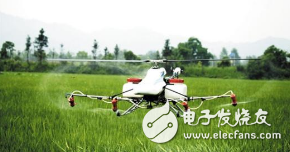The trend of global integration is accelerating, and intelligent equipment has become a key element in the competition for national strength. Agriculture remains one of the most important industries supported by governments worldwide. As a result, there is still significant room for growth in China's agricultural plant protection sector. Recently, the development of plant protection drones has entered a period of policy support, with the "National Subsidy" initiative sending a strong signal to the industry. It is expected that more drones will be deployed in farmlands in the coming years, marking a new phase of development.
In recent years, as the technology behind plant protection drones has advanced rapidly, their applications have expanded significantly. This has led to increased demand from the industry for purchase subsidies. With the "National Subsidy" policy now entering its implementation stage, it is anticipated that the plant protection drone market will experience a new wave of growth, opening up broader opportunities for future development.

Plant protection drones are unmanned aerial vehicles used specifically for agricultural and forestry crop protection. They are commonly used for spraying pesticides, seeds, and fertilizers. Although the development of these drones has been accelerating in recent years, the entire industry is still in its early stages.
According to data from the China Industrial Information Network, the number of plant protection UAVs reached 2,324 units across 31 provinces in 2015, covering a total area of 11.528 million mu. This was a significant increase compared to 695 units and 4.26 million mu in 2014, representing growth rates of 234% and 170.6%, respectively.
However, despite this growth, the proportion of plant protection drones in China’s overall UAV market remains below 1%. In contrast, the U.S. and Japan have achieved 50% and 54% penetration in their agricultural sectors, respectively, while the global average stands at 17%, which is much higher than China’s current level.
**The State Officially Launched the “National Subsidy†Policy**
To further unlock the potential of the plant protection drone market and accelerate the industry’s development, the Ministry of Agriculture, the Ministry of Finance, and the Civil Aviation Administration jointly issued the "Notice on the Pilot Work for Guiding the Application of Plant Protection Unmanned Aircraft under the Agricultural Machinery Purchase Subsidy." The notice aimed to select six provinces—Zhejiang (including Ningbo), Anhui, Jiangxi, Hunan, Guangdong, and Chongqing—to conduct pilot programs in 2017.
The pilot funds were allocated from the central government’s agricultural machinery purchase subsidy budget, with each province receiving no more than 10 million yuan. The subsidy targets organizations engaged in plant protection operations, rather than individual buyers. Additionally, a fixed subsidy was introduced, with each unit receiving 30% of the average market price in 2017, capped at 30,000 yuan per machine. These drones must be used exclusively for agricultural purposes, and the subsidy is directly given to the purchasers.
**Local Provinces Speed Up Implementation of Subsidies**
With the official launch of the "National Subsidy" policy, local governments have also begun implementing the program quickly. Recently, both Jiangxi Province and Chongqing Municipality have taken action to promote the initiative.
Chongqing’s Agriculture Commission, together with the Finance Bureau and the Civil Aviation Regulatory Authority, issued a notice stating that from October 30, 2017, to March 30, 2018, the city would introduce a subsidy program for plant protection drones. The goal was to guide the standardized application of these drones and promote green agricultural development.
The subsidy targets agricultural production organizations involved in plant protection, such as farmer cooperatives and pest control agencies. The subsidy amount for single-rotor drones was set at 29,000 yuan, while multi-rotor models received 16,000 yuan each, including batteries.
Jiangxi also released its own pilot plan, focusing on grain-producing counties and citrus-growing areas. The plan specified that the drones should be electric multi-rotors with a drug capacity between 10L and 15L, and at least four batteries. Each subsidy was set at 17,000 yuan, and the pilot covered 64 counties across the province.
As the "National Subsidy" policy continues to take effect locally, it is expected to drive steady growth in the plant protection drone market. While not all provinces have yet included these drones in their subsidy programs, the national-level push suggests that the industry is on the verge of a major breakthrough. With continued cost reductions and improved performance, the future of plant protection drones looks promising.
Voltmeter Display,Mini Voltmeter Display,Digital Panel Voltmeter,Voltmeter Lcd
Dongguan Andu Electronic Co., Ltd. , https://www.autoido.com